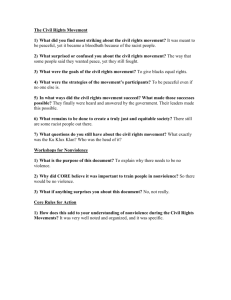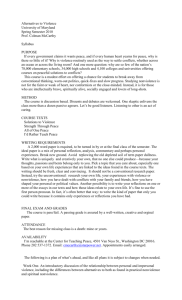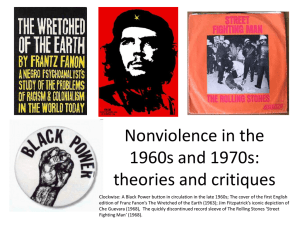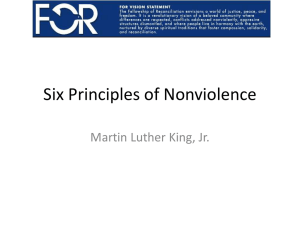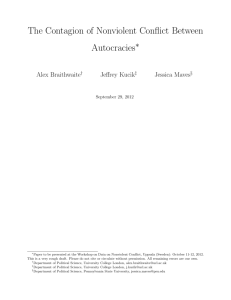Detailed Outline Integrating Sources with List of Sources.
advertisement
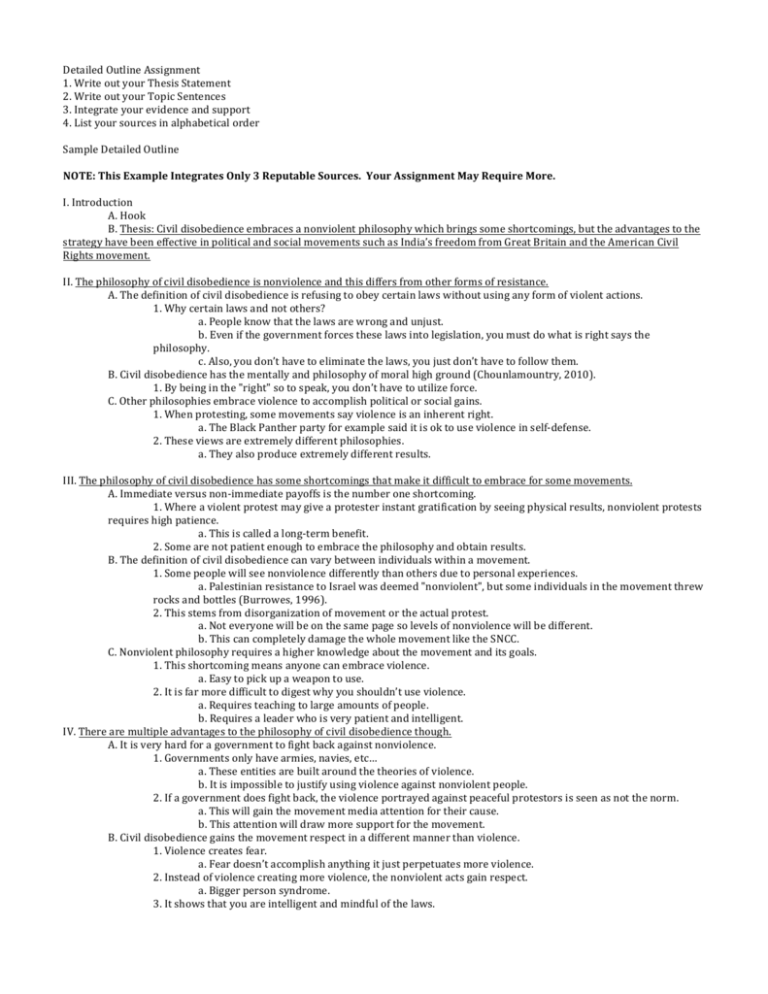
Detailed Outline Assignment 1. Write out your Thesis Statement 2. Write out your Topic Sentences 3. Integrate your evidence and support 4. List your sources in alphabetical order Sample Detailed Outline NOTE: This Example Integrates Only 3 Reputable Sources. Your Assignment May Require More. I. Introduction A. Hook B. Thesis: Civil disobedience embraces a nonviolent philosophy which brings some shortcomings, but the advantages to the strategy have been effective in political and social movements such as India’s freedom from Great Britain and the American Civil Rights movement. II. The philosophy of civil disobedience is nonviolence and this differs from other forms of resistance. A. The definition of civil disobedience is refusing to obey certain laws without using any form of violent actions. 1. Why certain laws and not others? a. People know that the laws are wrong and unjust. b. Even if the government forces these laws into legislation, you must do what is right says the philosophy. c. Also, you don’t have to eliminate the laws, you just don’t have to follow them. B. Civil disobedience has the mentally and philosophy of moral high ground (Chounlamountry, 2010). 1. By being in the "right" so to speak, you don’t have to utilize force. C. Other philosophies embrace violence to accomplish political or social gains. 1. When protesting, some movements say violence is an inherent right. a. The Black Panther party for example said it is ok to use violence in self-­‐defense. 2. These views are extremely different philosophies. a. They also produce extremely different results. III. The philosophy of civil disobedience has some shortcomings that make it difficult to embrace for some movements. A. Immediate versus non-­‐immediate payoffs is the number one shortcoming. 1. Where a violent protest may give a protester instant gratification by seeing physical results, nonviolent protests requires high patience. a. This is called a long-­‐term benefit. 2. Some are not patient enough to embrace the philosophy and obtain results. B. The definition of civil disobedience can vary between individuals within a movement. 1. Some people will see nonviolence differently than others due to personal experiences. a. Palestinian resistance to Israel was deemed "nonviolent", but some individuals in the movement threw rocks and bottles (Burrowes, 1996). 2. This stems from disorganization of movement or the actual protest. a. Not everyone will be on the same page so levels of nonviolence will be different. b. This can completely damage the whole movement like the SNCC. C. Nonviolent philosophy requires a higher knowledge about the movement and its goals. 1. This shortcoming means anyone can embrace violence. a. Easy to pick up a weapon to use. 2. It is far more difficult to digest why you shouldn’t use violence. a. Requires teaching to large amounts of people. b. Requires a leader who is very patient and intelligent. IV. There are multiple advantages to the philosophy of civil disobedience though. A. It is very hard for a government to fight back against nonviolence. 1. Governments only have armies, navies, etc… a. These entities are built around the theories of violence. b. It is impossible to justify using violence against nonviolent people. 2. If a government does fight back, the violence portrayed against peaceful protestors is seen as not the norm. a. This will gain the movement media attention for their cause. b. This attention will draw more support for the movement. B. Civil disobedience gains the movement respect in a different manner than violence. 1. Violence creates fear. a. Fear doesn’t accomplish anything it just perpetuates more violence. 2. Instead of violence creating more violence, the nonviolent acts gain respect. a. Bigger person syndrome. 3. It shows that you are intelligent and mindful of the laws. a. This shows that your group is not quick to grab a gun, rather to sit and talk about things and make real progress. C. Another advantage is that civil disobedience conveys moral superiority. 1. This lifts the spirits of people inside and outside of your organization. a. It will have a snowball effect and lead to further nonviolence. b. If nonviolence can be adhered to, it will grow upon itself from this moral superiority. V. Nonviolence has been effective in multiple movements such as India’s fight for freedom against Great Britain and the African American struggle in the American Civil Rights Movement. A. Mahatma Gandhi used nonviolence as a tool to fight against British rule over India in the early to mid 1900’s. 1. His idea was Satyagraha. a. Truth is a force that holds power beyond violence and weapons. b. He implied the moral superiority argument saying the people of India were right and the British government was conducting evil acts. c. He said no violence whatsoever was permitted during protests. 2. Gandhi was eventually able to influence millions of people soon there after. a. Initially, people said it was impractical. b. Strict following of ethical boundaries and nonviolence overcame this doubt. c. Used Salt March to make own salt, nonviolently. 3. Being steadfast while in and out of jail, Gandhi was nonviolent the whole movement. a. India finally won its independence in 1950. 4. His effectiveness using nonviolence basically got India its freedom. B. The effectiveness of nonviolence can also be seen in the American Civil Rights Movement. 1. This successful idea that was spawned by Gandhi was embraced by Martin Luther King Jr. a. Some of the black people looked closely at Gandhi’s nonviolent revolutionary movement in India and, while recognizing important differences, saw a possible source of hope (Carson et al, 1991). 2. Many effective nonviolent tactics were used by African Americans during their struggle. a. Bus boycotts like Rosa Parks used no violence but got attention. b. Sit-­‐ins were a massive nonviolent strategy used in the South by both blacks and whites to protest unjust laws. c. This form of black nonviolent protest, understanding satyagraha, weakened the white communities resole, unity, and readiness to retaliate with violence. It placed blame on the system, not personal segregationists (Sitkoff, 2008). i. The effectiveness is extremely high and apparent when the system, not people, get attacked. ii. This is exactly what Dr. King wanted. d. Freedom Rides were used too. 3. The civil disobedience in the Civil Rights Movement was evident by legislation passed shortly there after. a. Much like India gained independence, African Americans gained independence from lasting oppression. b. C.R.A., V.R.A., and A.A. were all passed. c. Congress, the President, and the Courts were extremely influenced by the nonviolence the movement employed. d. The American public was also influenced due to massive respect and the effectiveness of the movement. 4. Nonviolence in the American Civil Rights Movement proved effective in the long haul. VI. Conclusion. A. Restate thesis. B. Closing thoughts. 1. Good if you can stick to it. Work Cited Page Burrowes, Robert. The Strategy of Nonviolent Defense: A Gandhian Approach. New York: State University of New York Press, 1996. Print. Carson, Clayborne, et al. The Eyes on the Prize: Civil Rights Reader. New York: Penguin Group, 1991. Print. Chounlamountry, Som. "Strategies in the Civil Rights Movement". California State University Long Beach. Long Beach, CA. 01 Mar. 2010. Sitkoff, Havard. The Struggle For Black Equality. New York: Hill and Wang, 2008. Print.
